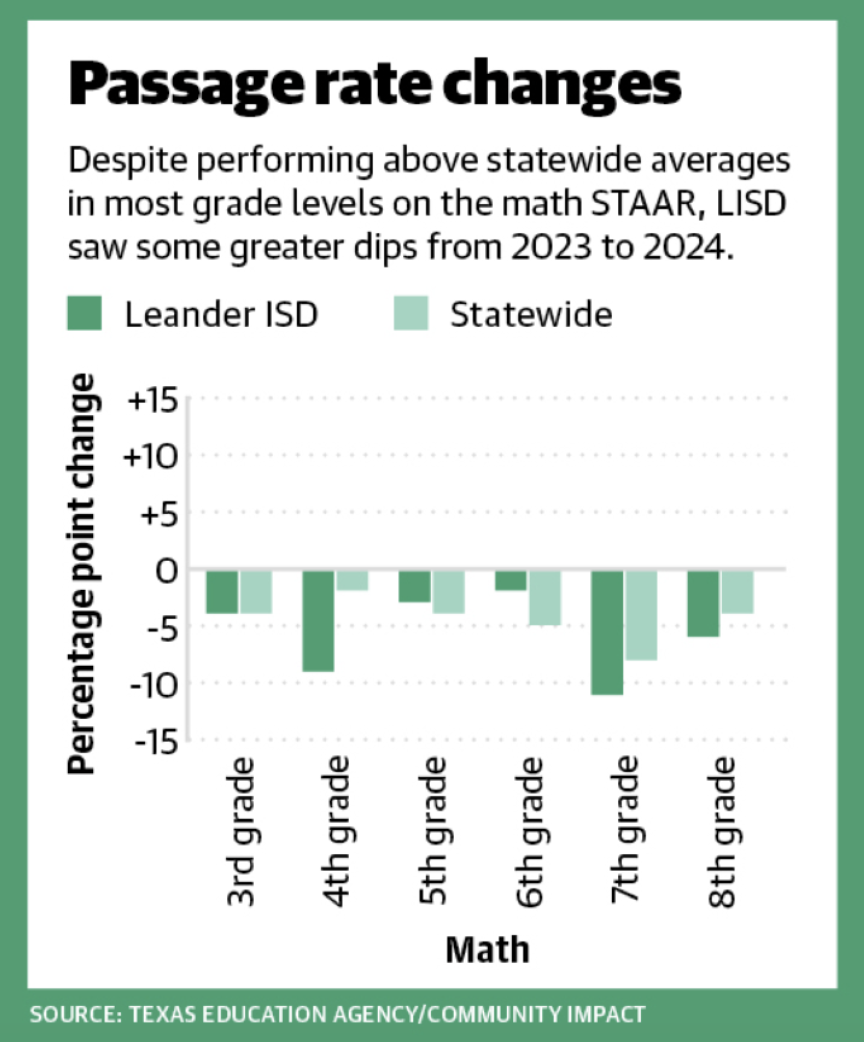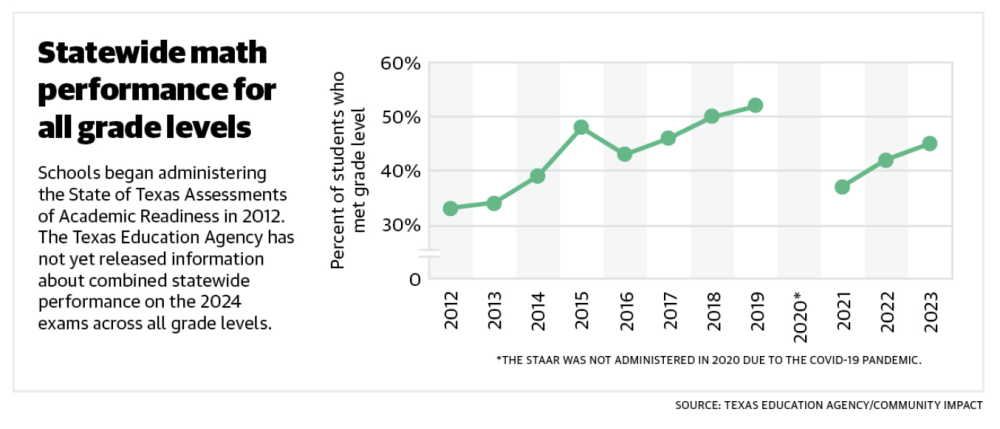This comes as the percentage of third through eighth grade students in Leander ISD approaching grade level, or passing, the math State of Texas Assessments of Academic Readiness declined for every grade from spring 2023 to spring 2024.
This decline isn’t isolated to LISD. As a state, the percentage of Texas students approaching grade level in math in 2024 also declined for each grade.
“Math scores are something that we are concerned about and that we’re really focusing a lot of our discussions on,” LISD school board President Gloria Gonzales-Dholakia said.
The overview
Taken each spring, students receive a STAAR score of “did not meet grade level,” “approaches grade level,” “meets grade level” or “masters grade level” for each subject. Students who approach their grade level and above have passed the test, while students who meet their grade level and above are considered proficient.
The setback in LISD scores this year comes as students across the state have struggled to return to pre-coronavirus pandemic test scores in math. Local and state math performance has improved some but has yet to return to performance levels from 2019.
This year’s scores are the first since 2021 that have declined across the board, according to data from the Texas Education Agency.

Zooming out
In 2019, an average of 52% of Texas students across all grades met grade level on the math STAAR—the highest percentage since the inception of the test in 2012.
The test was not administered in 2020 due to the pandemic. In 2021, student performance statewide fell by 15 percentage points, a decline experts largely attribute to learning loss following remote learning and the stresses of the pandemic.
However, experts say the COVID-19 pandemic highlighted existing issues with math education, including insufficient training for teachers and a lack of early intervention for struggling students.
“The narrative around education right now is, how do we get back to pre-COVID levels? But the reality of the situation is, even at our peak, [math] achievement was at [52%],” said Gabe Grantham, an education policy adviser for nonpartisan think tank Texas 2036. “We have to dream a lot bigger than just prepandemic levels.”
Grantham said state leaders need to ensure schools identify students who struggle with math early on. Texas students take early reading “screeners,” which measure reading comprehension and development, at the beginning of kindergarten, but there is not a similar requirement for math. However, LISD administers universal screeners to measure students’ math performance beginning in kindergarten, district officials said.
On the state level, this means many students with math deficiencies are not identified until they begin taking the STAAR in third grade, Grantham said.
Furthermore, Grantham said districts and the state need to make sure math teachers have access to ongoing professional development opportunities. According to Texas 2036, 36% of Texas principals say their teachers “demonstrate a deep understanding” of math teaching methods.
“Math is a hard subject to teach because it requires so much content and pedagogical knowledge; you have to understand the actual mathematical concepts you’re teaching and also know how to teach math well, which is exceptionally difficult,” Grantham said.

Brenda Cruz, LISD assistant superintendent of empowered learning, told Community Impact it’s difficult to pinpoint one reason student performance suffered in 2024 as the causes may differ for each child and grade level.
The district doesn’t consider a difference of a couple of percentage points as a drop in performance but notes when there is a change of 4 or more percentage points, she said.
While parents may have felt comfortable regularly reading with their children during the pandemic, families have often relied on educators to teach their children math skills, said Alicia Westcot, senior director of math and science curriculum.
“[Parents] might count numbers, but as we start getting into some of those more intricate math skills, not as much of that happens on a regular basis at home as does sitting and reading with a book,” Westcot said.
Furthermore, in 2023, the state redesigned the STAAR to be administered fully online and feature more open-ended questions as opposed to multiple choice, a factor Gonzales-Dholakia said she believes negatively impacted student performance.
The approach
LISD officials stressed the importance of considering a range of assessments in evaluating students’ performance—not just the STAAR.
“We don’t want to look at one number to define a student’s abilities or their trajectory for learning,” Westcot said. “We want to look at what we would call a collection of evidence.”
Even when looking across multiple assessments, however, Gonzales-Dholakia said the district recognizes it needs to improve math performance.
“We know that there’s work that we need to do in math because regardless of the moving target, regardless of the pandemic, this is where we’re at,” she said.
A district presentation from February showed students did not display the expected level of growth in math during the middle of the 2023-24 school year, which former Area Superintendent Christine Simpson tied to teacher turnover.
Texas as a whole is grappling with high teacher turnover and rising rates of uncertified teachers, according to the TEA. Students taught by uncertified educators without classroom experience lose three to four months of reading and math learning, according to a study by Jacob Kirksey, an assistant professor of education at Texas Tech University.
LISD's focus on math
- Reviewed curriculum for second through fifth grade teachers
- Hired five elementary school math specialists and one secondary school math specialist
- Hired five new co-teachers
- Renewed commitment to professional learning communities
Under state law, students who receive a score of “did not meet grade level” must undergo accelerated instruction at school. Some students will be taught by a highly skilled teacher for the following school year, and others will receive at least 15 hours of small-group tutoring on specific subjects.
This school year, LISD will begin administering its district assessments to students, which are focused on LISD’s curriculum and became optional in recent years.
LISD has also implemented “Building Thinking Classrooms”—a book that demonstrates optimal math teaching practices—into its professional development for teachers this school year, Westcot said.
Additionally, the district is looking to provide parents with various math resources they can use at home, Gonzales-Dholakia said.
“We’re hoping that these are different tools, fun tools, that are as easy to pick up as a book and read at home,” she said.






